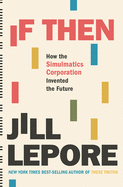
It seems there isn't an aspect of contemporary life that hasn't felt the impact of big data and data analytics. But familiar as those terms may be, the early days of the science behind them is likely equally obscure. Harvard historian and New Yorker journalist Jill Lepore's If Then: How the Simulmatics Corporation Invented the Future unearths that history in a fascinating account that's both illuminating and cautionary.
Founded in 1959 and bankrupt by 1970, Simulmatics Corporation was the brainchild of Ed Greenfield, a Madison Avenue advertising executive who dabbled in Democratic politics and had an affinity for the civil rights movement. Greenfield's goal, as Lepore (Joe Gould's Teeth) describes it, was to "automate the simulation of human behavior" through a computer program nicknamed the "People Machine."
Simulmatics first came to prominence in 1960, when John F. Kennedy's presidential campaign hired it to undertake a study of the Black electorate. At the heart of Lepore's story, though, is a detailed recounting of Simulmatics's shadowy role assisting the United States' counterinsurgency program in Vietnam. The company's crew of "oddballs, has-beens, and outcasts" oversaw an array of studies that sought insight into the hearts and minds of the Vietnamese people. In the end, however, this psychological warfare research proved as ineffectual as the United States' actual military effort.
While Simulmatics's record of accomplishment ultimately was less than impressive, understanding its story is essential for anyone who wants to appreciate large aspects of how modernity launched into a hyperconnected and uneasy present. --Harvey Freedenberg, freelance reviewer

